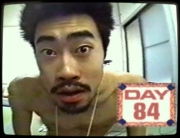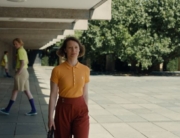Polymath James Franco’s writes, directs, and stars in As I Lay Dying, an adaptation of William Faulkner’s 1930 novel. It’s an ambitious undertaking widely considered impossible to film because of the novel’s literary style. Franco remains faithful to the book’s plot but experiments with film form in trying to capture the stream of consciousness and the multiple narrators’ perspectives.
While poor Mississippi matriarch Addie Bundren (Beth Grant) lies dying on the family farm, friends and family gather to pay their last respects while her eldest son, Cash (Jim Parrack), prepares her coffin in her sight. After Addie’s death, her husband, Anse (Tim Blake Nelson), her four sons—Cash, Darl (James Franco), Jewel (Logan Marshall-Green), and the youngest, Vardaman (Brady Permenter)—and daughter Dewey Dell (Ahna O’Reilly) embark on a quest to honor her dying wish to be buried in the town of Jefferson, Missouri.
As they set out by horse and cart, heavy rain causes floods, and the bridge over a swollen river collapses. The disastrous river crossing is effectively conveyed in split screen and slow motion with underwater footage and submerged sound. Negotiating the fierce current, a log collides with the wagon breaking Cash’s leg, and Addie’s coffin floats free. While the injured horses drown, the brother’s scramble to retrieve Addie’s casket and Cash’s carpentry tools. Determined to reach Jefferson, Anse ignores all advice, and the Bundrens detour to a makeshift ford.
After securing mules and “fixing up” Cash’s leg, they continue. Delayed by the disaster, Addie’s decomposing body attracts circling vultures and widespread revulsion on their odyssey across the South. As each struggles to come to terms with their loss and circumstances, motivations, both noble and selfish, and conflict surface on the grueling journey.
Casting himself as Darl, the primary narrator, James Franco is understated and faithful to Faulkner’s poetic interior monologues that surpass his character’s intellect. Jim Parrack is persuasive as the dutiful and selfless Cash. As Addie’s illegitimate, favorite son Jewel, the headstrong outsider, Logan Marshall-Green is dynamic. Ahna O’Reilly is all too credible as the painfully naive country girl, Dewey Dell. Only Tim Blake Nelson strikes a note of caricature overplaying the physicality of Anse, the inarticulate, selfish father.
Set and shot in Mississippi, Christina Voros’ cinematography beautifully captures the surrounding and the forces of nature with a nod to Emmanuel Lubezki’s work with Terence Malick. In his attempt to visualize Faulkner’s literary techniques, Franco plays with a myriad of devices employing narration, addressed directly to the camera, and surreal sequences. In the editing, Ian Olds combines split screen, alternating shot distances and angles, and monologues play over the action, both synced and unsynced to the images. The effectiveness of these devices is uneven, sometimes distracting and obscuring a character, at other moments successfully conveying the tension and tragedy. In one monologue, Addie bluntly expresses her regrets from the coffin recounting her desire for freedom and resentment of her children.
It’s a brave and respectful adaptation of the novel but the film suffers from its faithfulness. Franco’s visualization of the fractured experiences seems pretentious and disjointed at times. That said, the cruel realities of this poor 1930s farming family, and particularly the gender divide, resonates.






Leave A Comment